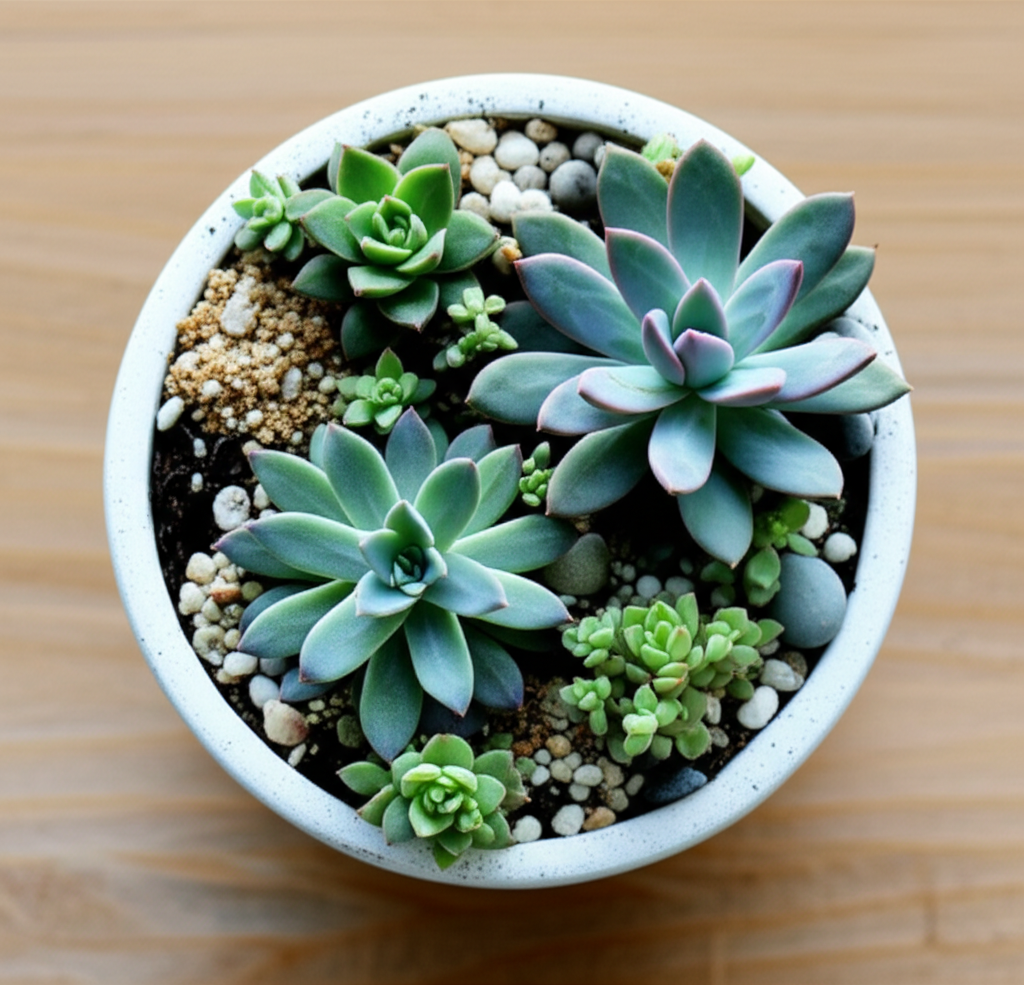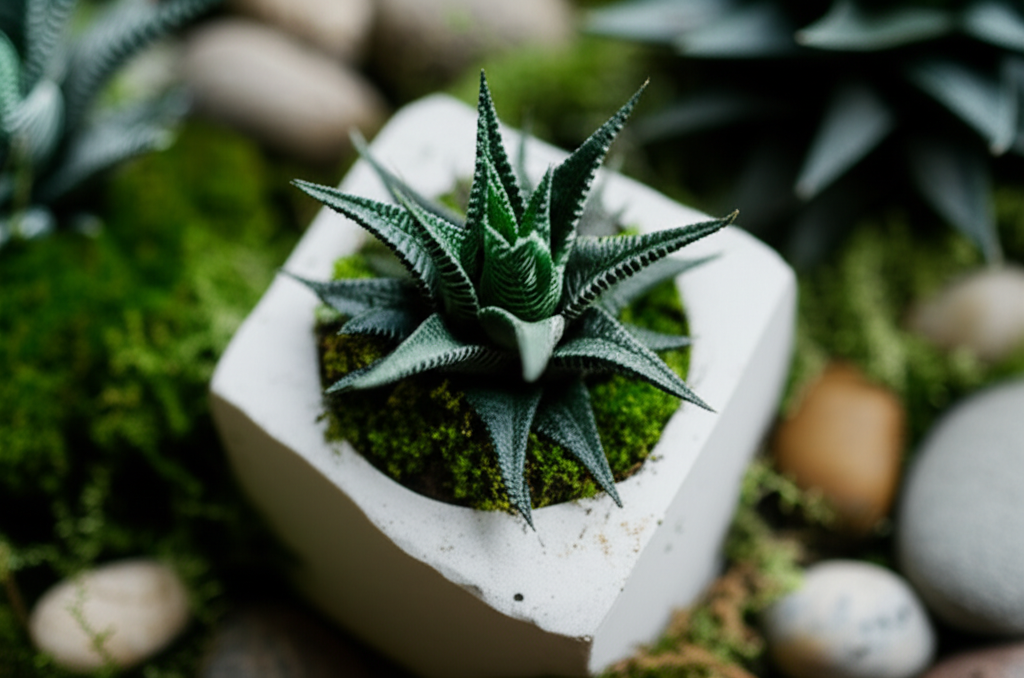Introduction: The Allure of Tiny Gardens and Ice Plants
The allure of cultivating miniature worlds within our homes has never been stronger. Tiny indoor gardens offer a delightful escape, bringing a touch of nature indoors and fostering a sense of accomplishment with each new bloom or healthy leaf. Among the most captivating subjects for such endeavors are succulents, renowned for their resilience, unique forms, and low-maintenance nature. Specifically, the “Ice Plant” succulent, belonging to the Aizoaceae family, stands out with its mesmerizing crystal-like epidermal cells that shimmer and refract light, giving it a frosted appearance. This article will guide you through the rewarding process of creating your own ice plant succulent tiny indoor garden, covering everything from selecting the right varieties to ongoing care and creative display ideas.
Understanding the Ice Plant Succulent

Before we delve into the crafting aspect, it’s crucial to understand what makes ice plant succulents so special. These fascinating plants are not a single species but rather a diverse group characterized by their distinctive “papillae” – specialized epidermal cells filled with water. These papillae bulge outwards, creating a bumpy, textured surface that can appear crystalline or frosted, hence the common name “ice plant.” This unique adaptation helps them conserve water and reflect sunlight, crucial for survival in their native arid environments.
Key Characteristics
- Foliage: The defining feature is their succulent leaves, which can be smooth, bumpy, or covered in translucent, bladder-like cells. The shape and size vary dramatically across species.
- Flowers: Many ice plants produce vibrant, daisy-like flowers, often in shades of yellow, pink, red, or white, which can be quite showy.
- Growth Habit: They can range from low-growing ground covers to slightly more upright forms.
- Water Needs: Like most succulents, they are drought-tolerant and prefer their soil to dry out completely between waterings.
- Light Requirements: They thrive in bright, indirect sunlight, with some varieties tolerating more direct sun than others.
Popular Ice Plant Varieties for Tiny Gardens
Not all ice plants are equally suited for small-scale indoor gardening. Some species are more compact and manageable, making them ideal for terrariums, miniature planters, or small decorative arrangements.
- Lithops (Living Stones): Perhaps the most famous ice plants, these are masters of camouflage, resembling pebbles or stones. They are incredibly slow-growing and exceptionally drought-tolerant.
- Conophytum: These are tiny, cluster-forming succulents with rounded, often velvety leaves. They are perfect for miniature arrangements and many produce prolific, small flowers.
- Pleiospilos nelii (Split Rock): Similar to Lithops but often with a more pronounced fissure, these succulents also mimic rocks and have a slow, steady growth habit.
- Fenestraria aurantiaca (Baby Toes): These succulents have finger-like leaves that are tipped with translucent “windows,” allowing light to penetrate to the photosynthetic parts of the leaf.
- Cheiridopsis: Some species in this genus offer interesting leaf shapes and textures, often with a somewhat frosty appearance.
Key Facts & Comparison of Popular Ice Plant Succulents
To help you choose the best ice plant for your tiny garden, here’s a comparative overview of some popular options.
| Succulent Type | Scientific Name | Distinctive Feature | Ideal Light | Watering Frequency (Dormancy Excluded) | Growth Rate | Best For |
|---|---|---|---|---|---|---|
| Living Stones | Lithops spp. | Mimics pebbles, masters of camouflage | Bright, direct to indirect sun | Very infrequent (monthly or less), water only when wrinkled | Very slow | Beginners, low-traffic areas, minimalist displays |
| Cone Plants | Conophytum spp. | Small, often fuzzy, clustered bodies | Bright, indirect sun | Infrequent (every 2-4 weeks), water when slightly softened | Slow to moderate | Miniature arrangements, fairy gardens, small pots |
| Split Rock | Pleiospilos nelii | Stone-like appearance with a prominent fissure | Bright, direct to indirect sun | Infrequent (monthly), allow soil to dry completely | Slow | Desert-themed arrangements, rock gardens |
| Baby Toes | Fenestraria aurantiaca | Finger-like leaves with translucent tips | Bright, indirect sun | Infrequent (every 2-3 weeks), water when leaves slightly deflate | Moderate | Window sills, small decorative pots |
Designing Your Tiny Indoor Garden: The Creative Process
Creating a tiny garden is a blend of horticulture and art. The goal is to establish a harmonious miniature ecosystem that showcases the unique beauty of your chosen ice plants.
1. Selecting Your Container
The container is the foundation of your tiny garden. For succulents, drainage is paramount.
- Terracotta Pots: Porous nature allows for better airflow and quicker drying of the soil, ideal for succulents.
- Ceramic Pots with Drainage Holes: Ensure they have adequate drainage holes to prevent waterlogging.
- Shallow Bowls or Trays: These are excellent for creating miniature desert landscapes with multiple plants.
- Glass Containers (with caution): While aesthetically pleasing, glass containers lack drainage. If used, a thick layer of drainage material (gravel) at the bottom is essential, and extreme care must be taken with watering. Consider open-top containers for better air circulation.
2. Choosing the Right Soil Mix
Succulents require a well-draining soil mix to prevent root rot. A standard potting mix is too dense.
- Commercial Succulent/Cactus Mix: Readily available and formulated for excellent drainage.
- DIY Mix: Combine 1 part potting soil, 1 part perlite or pumice, and 1 part coarse sand. This ensures good aeration and drainage.
3. Planning Your Layout
Think about how you want your tiny garden to look. Consider:
- Focal Points: Place a more striking specimen or a cluster of plants to draw the eye.
- Height Variation: If using multiple plants, arrange them to create visual interest.
- Texture and Color: Mix and match different ice plant varieties for a diverse aesthetic.
- Decorative Elements: Small stones, pebbles, or polished rocks can enhance the desert-like appearance.
Step-by-Step Crafting Guide
Now, let’s get our hands dirty and bring your tiny ice plant garden to life!
Step 1: Prepare the Container
Ensure your chosen container is clean and has drainage holes. If using a container without drainage, add a layer of coarse gravel or broken pottery shards at the bottom.
Step 2: Add the Drainage Layer (Optional, but recommended for non-draining containers)
A 1-2 inch layer of gravel or lava rock at the bottom of the container helps to create a reservoir for excess water, keeping it away from the roots.
Step 3: Add the Soil Mix
Fill the container with your well-draining succulent/cactus mix, leaving about an inch of space from the rim.
Step 4: Plant Your Ice Plants
Gently remove your ice plants from their nursery pots. If the roots are tightly bound, loosen them slightly. Arrange the plants in your container according to your planned layout. For Lithops and Conophytums, ensure the top of the plant is at or slightly above the soil line to prevent rot.
Step 5: Top Dressing
Add a layer of small decorative stones, gravel, or coarse sand around the base of the plants. This not only looks aesthetically pleasing but also helps to prevent moisture from sitting directly on the leaves and stems.
Step 6: Initial Watering (with caution)
Wait a day or two after planting before the initial watering, especially if the plants seemed stressed or you disturbed the roots significantly. Water sparingly, allowing excess water to drain. For Lithops, it’s often best to wait a week or two after repotting before watering.
Caring for Your Tiny Ice Plant Garden
The key to success with succulents is understanding their specific needs, which often revolve around light and water.
Light Requirements
- Most ice plants thrive in bright, indirect sunlight.
- A south- or east-facing window is often ideal.
- If your home doesn’t receive enough natural light, consider using a grow light.
- Observe your plants for signs of too much or too little light (stretching, pale color, or scorched spots).
Watering
- This is the most critical aspect of succulent care.
- Water thoroughly only when the soil is completely dry.
- For Lithops and Pleiospilos, watering is infrequent, often only monthly or even less during their dormant periods.
- For other varieties like Fenestraria, watering every 2-4 weeks might be appropriate during the growing season.
- Signs of underwatering include wrinkled or deflated leaves. Overwatering leads to mushy, discolored leaves and root rot.
- Reduce watering significantly during cooler months when plants are typically dormant.
Temperature and Ventilation
- Ice plants prefer average room temperatures.
- They can tolerate cooler temperatures during their dormant period, but protect them from frost.
- Good air circulation is beneficial to prevent fungal issues.
Repotting
- Ice plants are slow-growing and don’t require frequent repotting.
- Repot only when the plant has outgrown its container or the soil has become compacted, typically every 2-4 years.
- The best time to repot is usually in spring or early summer, before their active growing season.
Troubleshooting Common Issues
Even with the best intentions, problems can arise. Here are a few common issues and how to address them:
- Root Rot: The most common problem, caused by overwatering. If you suspect root rot, gently remove the plant from the soil, trim away any mushy or blackened roots, and let it dry out for a few days before repotting in fresh, dry soil.
- Stretching (Etiolation): This indicates insufficient light. Move the plant to a brighter location.
- Mealybugs or Spider Mites: These pests can sometimes infest succulents. Isolate the affected plant and treat with insecticidal soap or neem oil.
Creative Display and Styling Ideas
Once your tiny garden is established, consider how you can showcase its beauty.
Fairy Garden Elements
Incorporate miniature figurines, tiny houses, or decorative pebbles to create a whimsical fairy garden scene.
Desert Landscape
Use various sizes of sand, gravel, and larger decorative rocks to mimic a miniature desert environment.
Mixed Planters
Combine different ice plant varieties with other small succulents or air plants for a dynamic display.
Terrarium Accents
Place a small ice plant arrangement within a larger open terrarium as a unique focal point.
Monochromatic Schemes
Focus on plants with similar leaf colors but varied textures for a sophisticated, understated look.
Pros and Cons of Tiny Ice Plant Gardens
Like any gardening endeavor, there are advantages and disadvantages to creating a tiny ice plant garden.
| Pros | Cons |
|---|---|
| Space-Saving: Ideal for small apartments, desks, or windowsills. | Specific Watering Needs: Overwatering can easily kill succulents if not managed carefully. |
| Low Maintenance: Once established, they require minimal watering and care. | Light Dependency: Requires adequate bright light, which may necessitate grow lights in some homes. |
| Unique Aesthetics: The distinctive appearance of ice plants is captivating and a great conversation starter. | Slow Growth: Some varieties, like Lithops, grow very slowly, so patience is key. |
| Drought Tolerant: Excellent for busy individuals or those prone to forgetting to water. | Susceptibility to Root Rot: Poor drainage or overwatering can lead to fatal root rot. |
| Therapeutic Hobby: The act of gardening and nurturing plants can be very calming. | Sensitivity to Overcrowding: Too many plants in a small container can lead to competition for resources and poor air circulation. |
Conclusion: Nurturing Your Miniature Oasis
Crafting an ice plant succulent tiny indoor garden is a rewarding journey that combines creativity with the satisfying practice of horticulture. These resilient and uniquely beautiful plants offer a glimpse into the fascinating adaptations of desert flora. By understanding their specific needs for light, water, and soil, and by choosing the right varieties for your space, you can cultivate a captivating miniature oasis that brings a touch of shimmering, frosted beauty into your home. With a little patience and care, your tiny ice plant garden will thrive, offering a constant source of wonder and a testament to the resilience and artistry of nature.


